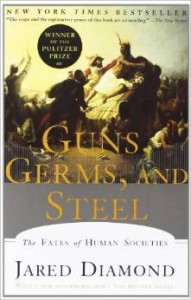Who would have thought that one reason civilization grew faster in EurAsia is that the continent is laid out ‘east to west’ vs North America / South America and Australia which is ‘north to south’?
Who would have believed that the domestication of animals was so complex and vital to human development?
We all hate germs but I didn’t realize how much of a factor germs were in European development across the world.
Well, Jared Diamond has done some “big” thinking in this book which I really enjoyed. It is a monster book of 440 pages, plus 29 pages of “Further Reading” related to each chapter but I could hardly put it down. He makes persuasive arguments of why Eurasia developed civilization faster than many other parts of the world while recognizing that no one human race was “smarter” than another. He has done extensive research in Papau New Guinea with some of the last hunter-gatherers in the world and when one of the natives there asked why the rest of the world was more advanced than his country, Jared began to put this book together.
Here are a couple of his arguments that he develops in the book.
- Hunter-gatherers must spend the majority of their time hunting and gathering. It wasn’t until humans began to grow crops that they could stay in one place and begin to accumulate things, have a class of people who worked the land and a class of people who could rule the land, create art, and develop crafts.
- Crops could be traded and move along the same latitude on earth which is why the east-west orientation of Eurasia was so effective in developing. Growing crops in Mexico and getting those same crops to Alberta Canada does not work as well.
- Domestication of animals was key in our development as well. There are 5 major animals that were domesticated and most of them were found in the Fertile Crescent area of the Middle East. Sheep, goats, cows, pig, and horses. These were the wild animals that could be grazed and eaten but also, in the case of horses, be used to help cultivate crops.
- Germs killed more Native Americans before Columbus got here than any cavalry. Germs come from human to animal contact (see above domestication) and when the very earliest people came to North America disease spread quickly and killed 10’s of thousands of Natives.
There are more interesting discussions on the why and how’s of human development that I found fascinating. His view of our human development is over 50,000 year view and integrates a number of different disciplines including archeologists, genetics, linguistics, and more.
This book is probably not for everyone as it is dense in places, but I found it very readable and understandable, and truly fascinating broader thinking than I could have done without the author really laying out his arguments of “Why Europe and not China?” and “Why did Spain take over the Mayans?” and “Why didn’t zebra’s domesticate but horses did?”.



Leave a Reply